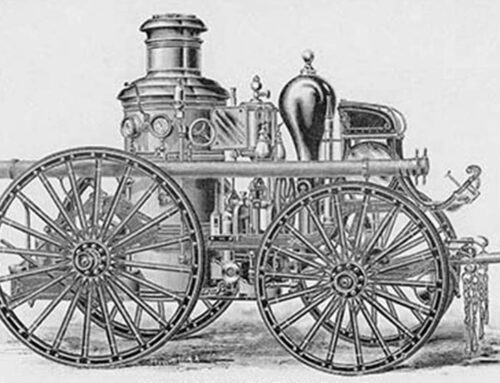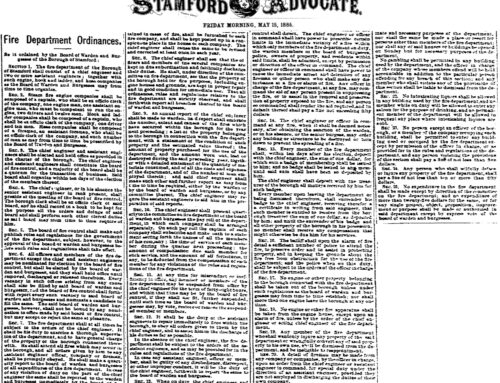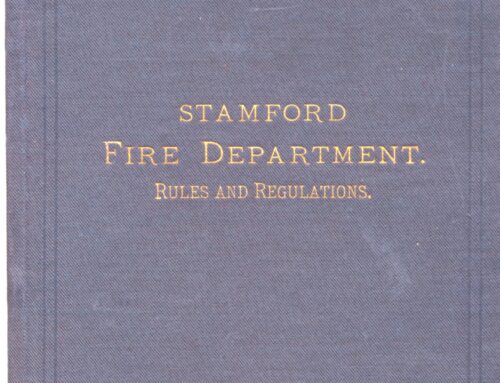By now Retired Firefighter Joseph Lombardo IV
If you were a brave Stamford resident that ventured out on the cold afternoon of
January 14″, 1914 for a copy of the Advocate your two cents would have bought a front
page of report of the S.F.D.’s fire duty from the day before. In the center of the paper
was a photo of the Stamford Yacht Club and its outbuildings taken from a yacht on the
Long Island Sound. It was a photo of something that no longer existed.

It was an extremely cold night on January 13, 1914, with the temperature reading
almost -10°, bitter gusts of wind that added to the misery of the men working at the
Luther St. firehouse and any citizens that ventured outside. All people in Stamford had
one thought stay warm, heaters and boilers were set as high as they could go. The men of
Chemical Engine Co. #1 were already tired. It has been a long day, seven runs by Spm
that night. Among the runs were one house fire caused by pipes being thawed in the
basement, two grass/ brush fires, and a mutual aid call to Springdale for a house fire on
Cemetery Rd.
Shortly after 9 pm a call for a reported fire was received for the Stamford Yacht
Club located on Ocean Drive West. Chemical Engine Co. #1 was the only motorized unit
in the Luther St. station, they were off and well on the way before the horse teams were
hitched up. Capt. Smith and his men were the first to arrive and there was hope that they
could put out this blaze with their 1″ chemical hose as they did at the earlier basement
fire. The rest of the responding units were still several minutes away.
They parked on the south lawn close to the building. They were directed to the
second floor by Mrs. Warren the Club cook who shouted that her room was on fire. AS
they climbed the stairs, down came the other club employees in the building. The men
had attempted to hold the fire with hand extinguishers. Capt. Smith was the first at the
top of the stairs and saw the fire was now pushing out the door. The men under his
command used their small line with great effect and pushed back the fire. Smith then
passed the hose stream to check the room next door. He opened the door of the Ladies
Bathroom and saw the fire had burned through the wall and was starting to eat its way
into the attic.
He knew at once that the fire was now well beyond the capabilities of his
company to control it. Soon the fire was now through the roof and he ordered his men to
retreat. As they exited the building Chemical #1 saw how out of control the fire had
become.
The fire was through the roof and the wind was carrying red hot embers into the
trees and the yachts that had been pulled onto the south lawn for the winter. The area had
become a landscape of flames; the building’s second-floor had become fully involved, the
treetops were now giant torches, and the yachts were being consumed so fast that the
chemical engine was close to igniting. The engineer of Chemical #1 scrambled through
the blazing terrain and drove the machine out to the comparative safety of the street.
By now the rest of the box alarm units had arrived and soon several streams of
water were aimed against the trees and the building. Despite the cold, a crowd had
gathered concerned that their residences might be next. It was not to be, it less than an
hour the building had collapsed in on itself. It was a complete loss, all of the trophies and
club memorabilia were gone as were the six boats on the south lawn. They comprised the
majority of a very popular class of racing yachts built by Milton Point Shipyard in Rye,
NY. The only structures left standing on the property were the bathhouses and pier.
They were spared because their location was north and upwind of the main club
building.
The fire was out by 10:30 pm that night and the freezing firefighters had packed
up their hose and returned to quarters. Other than a small grass fire at ll pm the rest of
the night was blessedly quiet. The S.F.D. was not called out until 8 am the next day when
the fire rekindled in the remains of the Yacht Club. It was the start of another tough day
as units later headed to a chimney fire and that afternoon to an attic fire on Garden St.
The cause of the fire was blamed on an oil heater placed too close to furnishings
in the corner of the cook’s room. The club was rebuilt by the summer of 1915 and still
stands today on Ocean Drive West.





